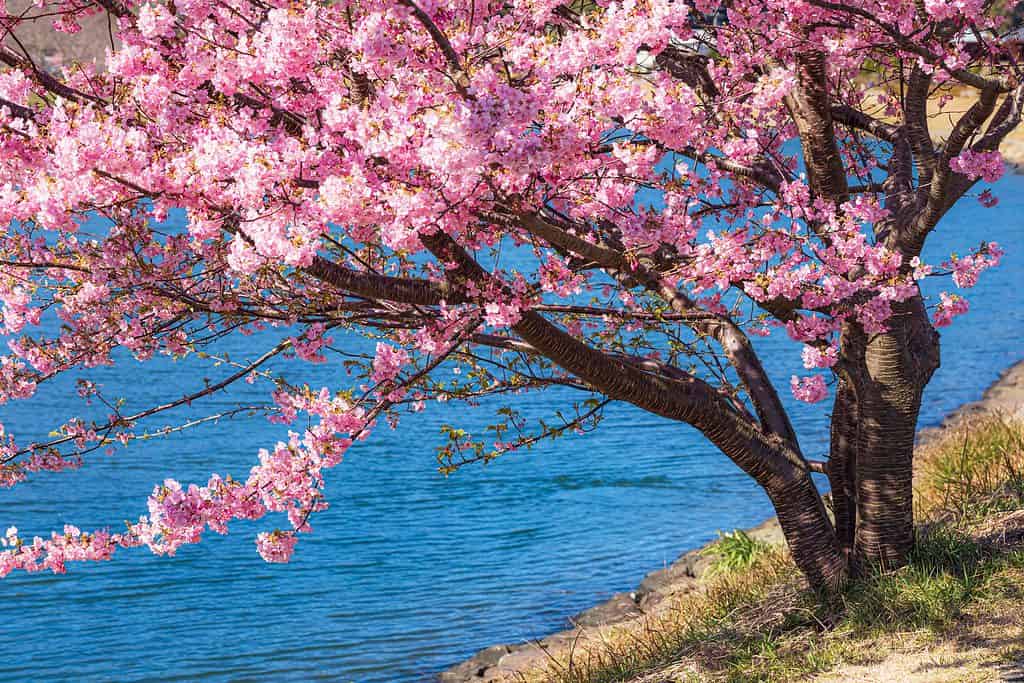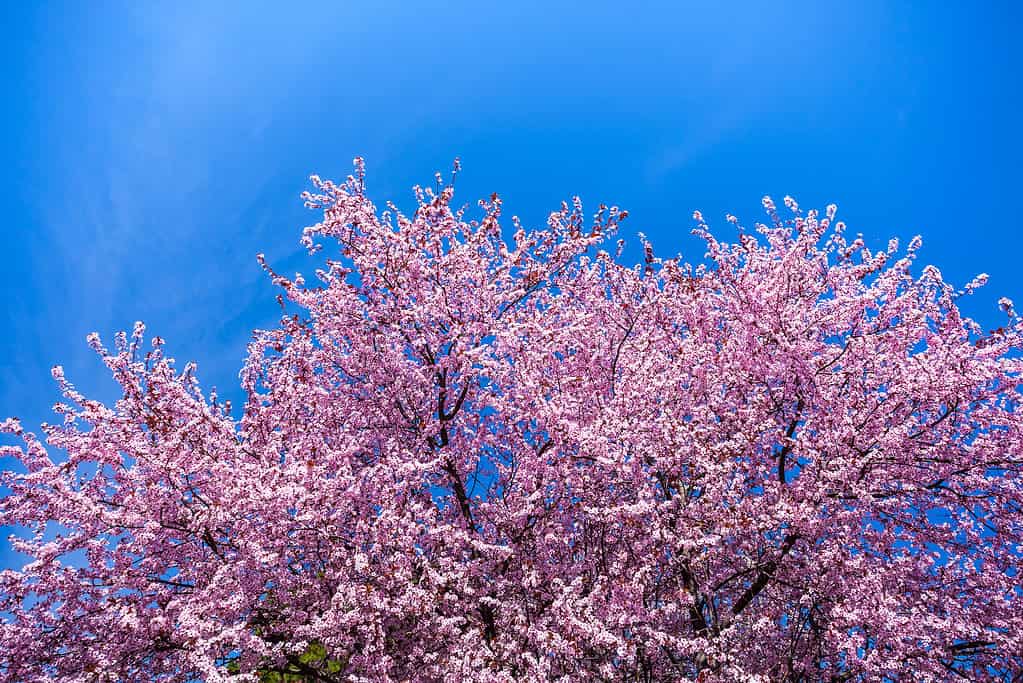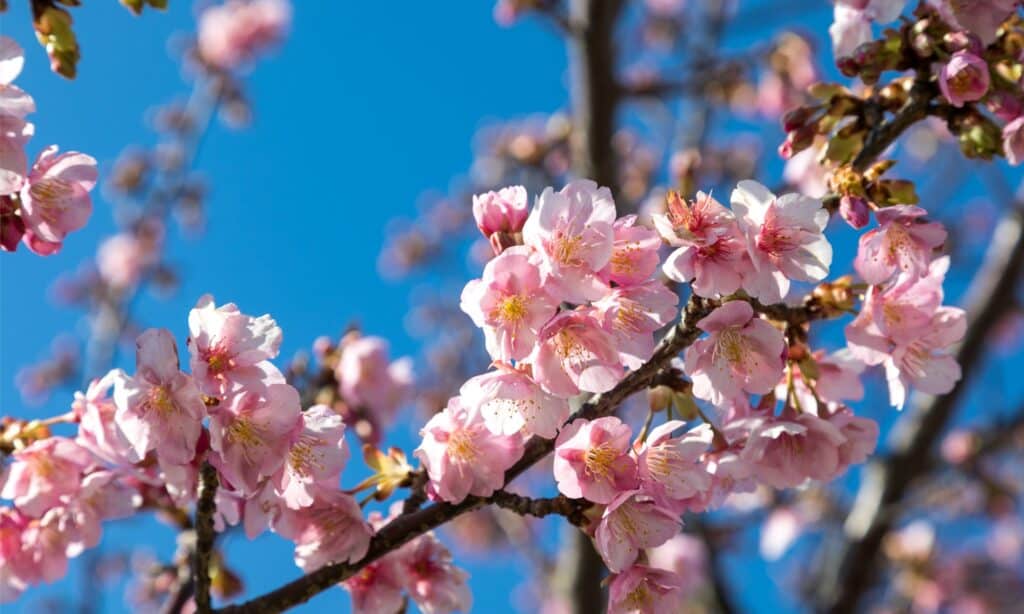Japan is a country known for its rich history and culture. The country is classified as an archipelago and is located off the east coast of Asia. In fact, the archipelago that creates Japan actually has 6,852 islands associated with it! Of these islands, there are four main ones — Kyushu, Honshu, Hokkaido, and Shikoku. The country is also covered in mountains with nearly 80% of the land being covered by them. Overall, this is a fascinating country, made even more interesting when you take into account the national flower of Japan: cherry blossoms.
Cherry blossom season is one of the most well-known aspects of Japan. These gorgeous flowers bloom across the country and many travel from across the world to see them! If you’ve ever been curious to learn more about cherry blossoms — you’re in luck. Here we’ll explore the characteristics of the cherry blossom as well as other fascinating facts about its place in Japanese culture.
The Geographic Context for Japan’s National Flower

©iStock.com/wataru aoki
Let’s start off by learning more about the geography and climate of Japan. Having a better understanding of the land will help us understand how cherry blossoms came to grow here. For starters, Japan’s climate is quite distinct depending on which part of the island you are on. The northern parts of Japan are known for having a subarctic climate while the south has a subtropical climate. In addition, the side of the island that is closer to the Pacific Ocean also has a different climate than the side closer to the Sea of Japan side.
Although Japan is a tiny country, it still has a lot of diverse landscapes to offer. As we mentioned above, mountains cover over 80% of Japan’s terrain. Additionally, Japan is located in the Pacific Ring of Fire. This means that they are surrounded by volcanoes — 186 to be exact. Out of these 186, there are sixty which are still active to this day. Since Japan is located in the Northern Hemisphere they have seasons that are similar to both North America and Europe.
This is also why Japan is known for its cherry blossom season! Let’s learn more about the cherry blossom and when and where they grow in Japan.
Cherry Blossoms: The National Flower of Japan

©iStock.com/k_samurkas
Cherry blossoms are the unofficial national flower of Japan. Although they have never been officially declared as the national flower, they are recognized as such because of their importance in Japanese culture. A cherry blossom, also known as Japanese cherry or sakura is a flower from a Prunus tree. There are many different types of Prunus trees and they are commonly found in East Asia. They are also considered ornamental trees. This means that they are beautiful to look at but they don’t produce any actual fruit.
If you’ve ever seen cherry blossoms in person, or even in photos, you’ll immediately recognize them thanks to their beautiful appearance. They bloom in the trees and are a gorgeous pink and white shade that immediately captures your gaze. It’s no wonder that people from around the world travel to Japan just to see these flowers bloom. Many cherry blossom festivals are held in parks throughout Japan. In the country, the cherry blossom tree that you’re most likely to encounter is the Somei Yoshino, also known as the Yoshino cherry. This tree is a hybrid of two other species. Now that we know more about cherry blossoms, let’s find out where they grow in Japan!
Where Do Cherry Blossoms Grow in Japan?
Throughout Japan, cherry blossoms grow in different seasons. The general season is between late March to April. However, the overall season can actually last four months because each part of the country has a different blooming season due to its geographic location.
For example, the southern islands of Okinawa have a subtropical climate. As a result, their cherry blossom season begins in mid-January. They say the best time to view them here is around early February.
If you travel to the southern cities of Kyushu, such as Kagoshima and Kumamoto, then the blooming season begins the last week of March and will reach its peak in early April. The more north you travel, the later the cherry blossom season begins. Osaka and Kyoto have bloom times that begin when March is on the precipice of ending. Tokyo as well has a bloom season that begins the last few days of March and their full blooming season happens in the first week of April.
If we go even more north, to the city of Hirosaki, the cherry blossom season will begin well into April. Finally, the northern island of Hokkaido has the latest blooms. The cities of Sapporo and Hakodate will have a bloom that begins the first week of May. As you can tell, cherry blossoms grow all throughout the country and this is why they have been so impactful in Japanese culture. Let’s explore some of the symbolism behind these beautiful flowers.
What Is the Cultural Significance of Cherry Blossoms?

©iStock.com/:Masaaki Ohashi
Cherry blossoms are absolutely gorgeous. As a result, you’ll find that Japan uses its imagery a lot. Landscape paintings will sport these gorgeous trees, while everyday consumer goods will also have cherry blossoms used as decor. They also appear in popular mangas, art, and animes. The cultural meaning behind cherry blossoms runs deep for the Japanese. This is why it is the unofficial national flower that is held with great reverence.
Since these flowers have such a short bloom time, they have often symbolized the mortality of humans. They are a symbol of human existence, serving as a visual reminder that our time on this earth is short and that we should be mindful while living fully in the present. In fact, the symbolism behind cherry blossoms has been around for a very long time. Hanami, which is the act of enjoying the beauty of flowers, was established as a ritual as early as 710 during the Nara period.
Sakura also symbolizes rebirth and renewal as they bloom every spring season. Ancient Japanese belief systems held that the gods lived in the mountains in the area. When the cherry blossom season began, they believed that it was a favorable sign that the gods would be coming to visit the villages. Therefore, sakura has always been noted as a time of beginning, renewal, and optimism.
What Are Cherry Blossoms Used For?
Cherry blossoms are so much more than an aesthetically pleasing flower. They are actually used in a lot of ways. Did you know that both the cherry blossoms and the leaves are actually edible? In fact, they are used in a lot of traditional Japanese teas and desserts. The cherry blossoms are first pickled and then can be used in a variety of recipes. You can add them to cookies, candies, mochi cakes, and more. There are even cocktails that are made with preserved cherry blossoms. In Japan, you can even find Sakura-infused versions of Coke, Pepsi, and Starbucks drinks. If you’re curious about what cherry blossoms taste like, they’ve been described as having a light and flowery flavor with a hint of cherry.
Other Native Plants and Flowers of Japan
There are about 4,500 different native plant species found in Japan. The unique climate and landscape of the country give way to tons of interesting flora. In addition to the cherry blossoms, there is actually another native flower that is unofficially recognized as a national flower in Japan. As the Imperial Emblem of Japan, the chrysanthemum is also unofficially recognized as the national flower. You’ll see this flower used in Japan a lot. For example, you’ll often see that it is printed on the covers of Japanese passports. Chrysanthemums first arrived in Japan in the fifth century. They were brought over from China. Eventually, the flower was adopted as the Imperial Seal of Japan.
The post Discover The National Flower of Japan: Cherry Blossoms appeared first on AZ Animals.
from Animal News, Facts, Rankings, and More! - AZ Animals https://ift.tt/mFS9nYg